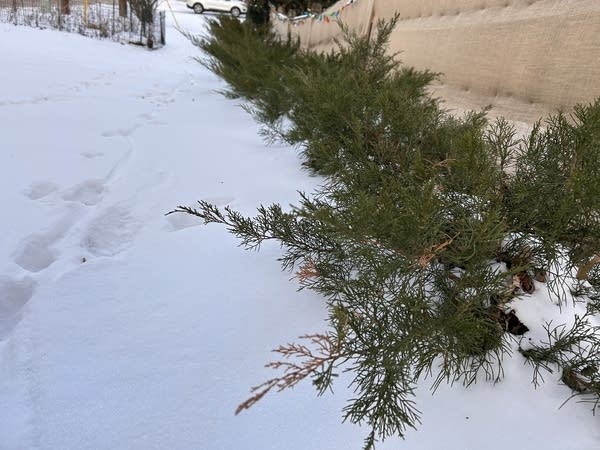The recent cold and lack of snow have been tough on garden plants.
“A lot of people think that snow is cold and it’s going to damage the plants but it’s actually the opposite,” said Dawson Kozlowski, general manager at Highland Nursery in St. Paul. “If there is no snow, those root systems are exposed to the extreme cold and wind that comes through.”
According to the Department of Natural Resources, frost is deeper across the state in 2025 than any year since 2019. Despite the recent snowfall, Minnesota has had much less snow than normal with conditions ranging from abnormally dry to severe drought in a small portion of the state.
Plants that aren’t protected by snow, especially evergreens, can become winter-burned. Exposed needles turn yellow or brown and fall off. Kozlowski said that in extreme cases, winter burn can completely kill off new plant growth.
Wrapping arborvitae and other evergreens with burlap can help prevent winter burn. You can trim off the damaged needles when green buds appear.
Brandon Miller, an assistant professor of horticulture at the University of Minnesota, said gardeners should be alert to rapid freeze-thaw cycles this winter. The expanding and shrinking ground can push plants up and partially out of the soil.
“Plants that are not well-established or plants that are recently planted are more likely to heave and actually pop out of the ground, which leaves their roots totally exposed,” Miller said.
If gardeners can see their plants’ roots, Miller said they should cover them in a layer of mulch, then replant them when spring comes.

Preparing for spring
If there isn’t enough snowmelt to nourish plants when they emerge from dormancy, their growth can be slow and limited.
“The snowmelt acts as a moisture for our soil here,” Kozlowski said. “The plants are waking out of their dormant period, so they’re going to want as much moisture and nutrients and everything as possible.”
After last year’s dry, warm winter, he said some plants flowered early while others were slow to mature. This didn’t affect Highland Nursery’s revenue, but it did push their peak business time to May and June — later than normal.
The earlier gardeners plant, the more time their shrubs and perennials will have to establish themselves, form healthy roots and become more resistant to frost heaving and drought. Kozlowski said some customers get a head start on the growing season by buying potted plants and keeping them inside at night until it’s warm enough to plant them.
“You really want to watch for that freeze and thaw. As soon as that ground starts thawing out, get your plants water,” Kozlowski said. “Especially if they look wilty or even just a little crispy.”
Miller recommends investing in hardy plants and trees that can survive a variety of conditions, like sun-loving purple coneflowers, shade-loving hostas and bitternut hickories. He said gardeners should consult their local nursery for area-specific recommendations.
If normal conditions prevail, Minnesotans can expect three to four more inches of snow in March. Long range weather predictions are slightly warmer than normal, but lows will regularly dip below freezing.

Collected from Minnesota Public Radio News. View original source here.
 Minnesota Public Radio (MPR) is a public radio network for the state of Minnesota. With its three services, News & Information, YourClassical MPR and The Current, MPR operates a 46-station regional radio network in the upper Midwest.
Last updated from
Minnesota Public Radio (MPR) is a public radio network for the state of Minnesota. With its three services, News & Information, YourClassical MPR and The Current, MPR operates a 46-station regional radio network in the upper Midwest.
Last updated from